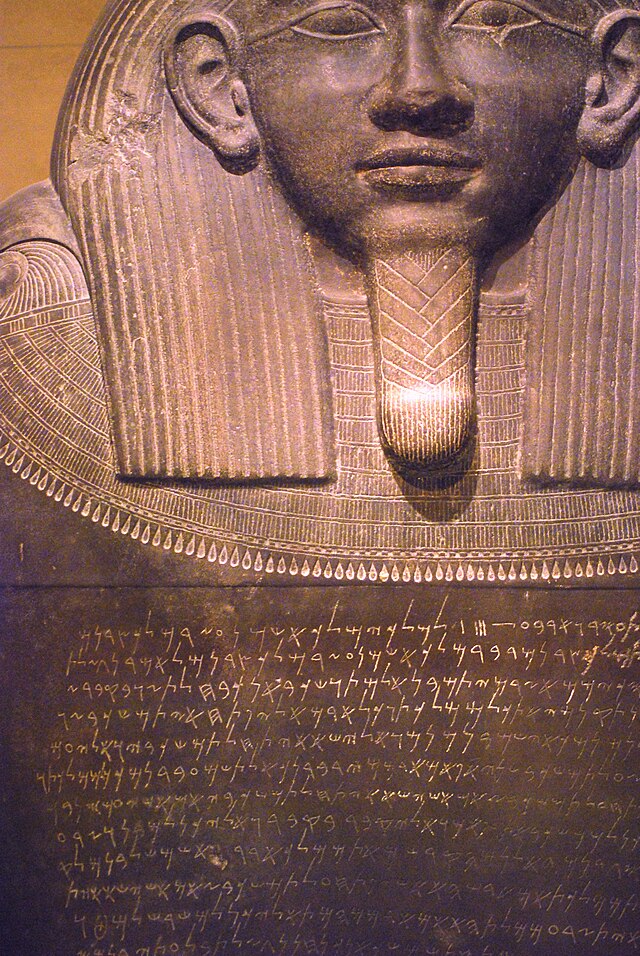| Name |
Image |
Discovered |
No. units |
Est. Date | Location found |
Current Location | Concordance |
|---|
| KAI | CIS / RÉS | NE | KI | NSI | TSSI |
Oth. ref. |
| Punic-Libyan bilinguals |
 |
1631 |
2 |
| Dougga |
British Museum | 100–101 | | 433,c | 93 | 52 | |
|
| Cippi of Melqart |
 |
1694 |
2 |
100s BC |
Malta |
Louvre and National Museum of Archaeology, Malta |
47 | I 122 | 425f | 53 | 36 | |
[29] |
| Carpentras Stela |
 |
1704 |
1 |
| Carpentras |
Bibliothèque Inguimbertine | 269 | II 141 | 448b1 | | 75 | II 24 |
|
| Pococke Kition inscriptions |
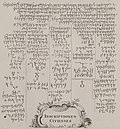 |
1738 |
31 |
300s BC |
Cyprus |
Ashmolean Museum |
33, 35 | I 11, 46, 57–85 | 420,4 | 19, 23, 27, 28 | 13, 16, 18, 19 | III 35 |
|
| Benhisa inscription |
 |
1761 |
1 |
| Malta |
Cabinet des Médailles |
| I 124 | 426,3 | 55 | | |
[29] |
| Phoenician Harpocrates statues |
 |
1770, 1963 |
2 |
| unknown |
National Archaeological Museum (Madrid) and British Museum | 52 | R 1507 | 424 | 44 | | III 37, 38 |
|
| Nora Stone |
 |
1773 |
1 |
| Sardinia |
Museo Archeologico Nazionale di Cagliari |
46 | I 144 | 427c | 60 | 41 | III 11 |
[29] |
| Athenian Greek-Phoenician inscriptions |
 |
1795 etc. |
18 |
| Athens, Piraeus |
British Museum, Louvre, National Archaeological Museum, Athens, Archaeological Museum of Piraeus | 53–60 | I 115–120, R 388, 1215 | 424,1–3, 425,1–5 | 45–52 | 32–35 | III 40–41 |
|
| Tripolitania Punic inscriptions |
 |
1806 |
|
| Leptis Magna, Breviglieri, other |
| 118–132 | R 662 | 434, B-a | | | |
|
| Elephantine papyri and ostraca |
 |
1815–1945 |
|
300s BC |
Elephantine |
various |
270–271 | II 137–139, 154–155 | | | 73–74 | II 26, 28 |
|
| Mdina steles |
 |
1816 |
2 |
| Malta |
National Museum of Archaeology, Malta |
61 | I 123A–B | 426,2 | 54 | 37 | III 21,22 |
[29] |
| Carthaginian tombstones |
 |
1817 onwards |
|
| Carthage |
Carthage National Museum, others | 85 | various | | 74 | | |
|
| Humbert Carthage inscriptions |
 |
1817-23 |
7 |
|
Carthage |
Rijksmuseum van Oudheden |
|
I 173, I 186-187, I 240, I 439-440 |
431, 9; 432, 16 |
|
|
|
|
| Turin Aramaic Papyrus |
 |
1823–24 |
1 |
|
|
Museo Egizio |
| II 144 | | | | |
|
| Blacas papyrus |
 |
1825 |
1 |
|
Saqqara |
British Library |
| II 145 | | | 76 | |
|
| Falbe Punic inscriptions |
 |
1831 |
3 |
|
Carthage |
Copenhagen University museum, British Museum |
|
I 199 |
431, 10 |
75 |
|
|
|
| Reade Punic inscriptions |
 |
1836-37 |
4 |
| Carthage, Maghrawa |
| 179, 441, 442 | | | | | |
|
| Limyra bilingual |
 |
1840 |
1 |
| Limyra |
| 262 | II 109 | 446b | | | |
|
| Abu Simbel Phoenician graffiti |
 |
1842 |
|
| Abu Simbel |
in situ | | I 111-113 | 423b | 43 | | |
|
| Ain Nechma inscriptions |
 |
1843 |
40 |
| Guelma |
Louvre |
166–169 | | 437 | | 58 | |
|
| Kellia inscription |
 |
1844 |
1 |
| Cyprus |
| 36 | I 47 | 420,5 | 24 | 17 | |
|
| Marseille Tariff |
 |
1845 |
1 |
300s BC |
Marseille |
Musée d'archéologie méditerranéenne |
69 | I 165 | 428 | 63 | 42 | |
[29] |
| Nimrud ivory inscriptions |
 |
1845, 1961 |
|
| Nimrud |
British Museum |
| | | | | I 6 |
|
| Assyrian lion weights |
 |
1845–1860 |
|
800–500 BC |
Nimrud, Abydos (Hellespont) |
British Museum, Louvre |
263 | II 1–14, 108 | 446c | | 66-67 | |
|
| Phoenician metal bowls |
 |
1849 onwards |
c. 5-10 |
700s BC |
Nimrud, Cyprus, Italy and others |
various |
| I 164, II 46–49 | | | | III 19 |
|
| Anat Athena bilingual |
 |
1850 |
1 |
312 BCE |
Cyprus |
in situ | 42 | I 95, R 1515 | 422,1 | 35 | 28 | |
|
| Bourgade inscriptions |
 |
1852 |
c. 40 |
| Maghrawa |
| 133–135 | | 436,3–12 | | 54 | |
|
| Sarcophagus of Eshmunazar II |
 |
1855 |
1 |
c. 525 BC | Sidon |
Louvre | 14 | I 3, R 1506 | 417,2 | 7 | 5 | III 28 |
|
| Gozo stele |
 |
1855 |
1 |
| Malta |
Gozo Museum of Archaeology |
62 | I 132 | 426,4 | 56 | 38 | |
[29] |
| Serapeum Offering Table |
 |
1855 |
1 |
400 BC |
Saqqara |
Louvre |
268 | II 123 | 448a2 | | 72 | |
|
| Cirta steles |
 |
1857–61, 1875, 1950 |
c. 1,000 |
300-100BCE | Constantine |
Musée national Cirta | 102–116, 162–164 | R 327, 334, 339, 1544 | 433,1–9 and 434,10–12 | 94–99 | 51 | |
|
| Carthage Tariff |
 |
1856-58 |
1 |
300 BC |
Carthage |
British Museum |
74 | I 167 | 429b | 66 | 43 | |
|
| Son of Baalshillek marble base |
 |
1856-58 |
1 |
| Carthage |
British Museum | 84 | I 178 | 430,7 | 73 | | |
|
| Carthage tower model |
 |
1856-58 |
1 |
|
Carthage |
British Museum |
|
I 181 |
432, 14 |
|
48 |
|
|
| Bodashtart inscriptions |
 |
1858, 1900-2 |
22-24 |
300s BC |
Sidon |
Louvre and Museum of the Ancient Orient |
15–16 | I 4, R 766, 767 | | 8–10 | 6, Appendix I | |
|
| Kition Resheph pillars |
 |
1860 |
2 |
341 BC |
Cyprus |
Louvre |
32 | I 10, 88 | 420,1 | 18, 30 | 12, 23 | |
|
| Ankh-Hapy stele |
 |
1860 |
1 |
525–404 BCE | unknown |
Vatican Museums | 272 | II 142 | 448b2 | | | II 7 |
|
| Pauli Gerrei trilingual inscription |
 |
1861 |
1 |
| Sardinia |
Turin Archaeology Museum |
66 | I 143 | 427b | 59 | 40 | |
[29] |
| Baalshamin inscription |
 |
1861 |
1 |
132 BC |
Umm al-Amad |
Louvre |
18 | I 7 | 418,d | 12 | 9 |
|
[30] |
| Phoenician sun dial |
 |
1860–1945 |
1 |
|
Umm al-Amad |
National Museum of Beirut |
|
I 9 |
|
|
|
|
|
| Umm al-Amad votive inscription |
 |
1861 |
1 |
|
Umm al-Amad, Lebanon |
Louvre | | I 8 | 419,2 | 13 | | |
|
| Cesnola Phoenician inscriptions |
 |
1865-71 |
28 |
|
Kition |
Metropolitan Museum of Art |
|
I 14-39, RES 1521-34 |
|
|
|
|
|
| Khaznadar inscriptions |
 |
1866-69 |
c.120 |
|
Carthage |
Bardo National Museum (Tunis), Louvre | 88 | various | 431,11-13, 431,15 | 82-84 | | |
|
| Hadrumetum Punic inscriptions |
 |
1867, 1946 |
12 |
| Sousse |
Hermitage Museum, Sousse Archaeological Museum, the Louvre and the Maison méditerranéenne des Sciences de l'homme | 97–99 | | 432,1–3 | 91–92 | | |
|
| Mesha Stele |
 |
1868 |
1 |
| Dhiban |
Louvre |
181 | | 415 | 1 | 1 | I 16 |
|
| Abydos graffiti |
 |
1868 |
|
| Abydos |
in situ | 49 | I 99–110, R 1302ff. | 423a | 38-42 | 31 | |
|
| Idalion bilingual and Idalion Temple inscriptions |
 |
1869 |
6 |
391–254 BC | Idalion, Cyprus |
British Museum | 38–40 | I 89–94 | 421,1–3 | 31–33 | 24–27 | III 34 |
|
| Yehawmilk Stele |
 |
1869 |
1 |
c.450/425 BCE |
Byblos |
Louvre | 10 | I 1 | 416 | 5 | 3 | III 25 |
|
| Tharros Punic inscriptions |
 |
1870 |
14 |
| Sardinia |
Museo Archeologico Nazionale di Cagliari, Museo nazionale archeologico ed etnografico G. A. Sanna | 67 | I 153-161 | | 61-62 | | |
[29] |
| Royal Steward inscription |
 |
1870 |
1 |
| Jerusalem |
British Museum |
191 | | | | | I 8 |
|
| Carthaginian slaughterhouse inscription |
 |
1871 |
1 |
| Carthage |
British Museum |
80 | I 175 | 430,4 | 68 | 46 | |
|
| Carthaginian mother goddess inscription |
 |
1871 |
1 |
| Carthage |
| 83 | I 177 | 430,6 | 72 | 47 | |
|
| Carthage Festival Offering inscription |
 |
1872 |
1 |
300 BC |
Carthage |
Turin Archaeology Museum | 76 | I 166 | 430,3 | 67 | 44 | |
[31] |
| Wilmanns Neopunic inscriptions |
 |
1873-74 |
5 |
| Tunisia |
Louvre and Vorderasiatisches Museum Berlin |
139, 142, 159 | | 435,2, 437a | | 53, 55 | |
|
| Pricot de Sainte-Marie steles |
 |
1874–75 |
>2,000 |
| Carthage |
Bibliothèque nationale de France, Louvre | 86–87 | I c.200–c.2000 | | 76-80 | 49 | |
|
| Cherchell Neopunic inscriptions |
 |
1875, 1882 |
2 |
| Cherchell |
Louvre | 161 | | 439,2 | | 56–57 | |
|
| Bashamem inscription |
 |
1877 |
1 |
200 BC |
Sardinia |
Museo Archeologico Nazionale di Cagliari |
64 | I 139 | 427a | 58 | 39 | |
[29] |
| Baal Lebanon inscription |
 |
1877 |
1 |
700s BC |
Cyprus |
Cabinet des Médailles |
31 | I 5 | 419 | 17 | 11 | III 17 |
|
| Saqqara Aramaic Stele |
 |
1877 |
1 |
482 BC |
Saqqara |
destroyed |
267 | II 122 | 448a1 | | 71 | II 23 |
|
| Tayma stones |
 |
1878–1884 |
21 |
300s–400s BC |
Tayma |
Louvre | 228–230 | II 113–115 | 447,1–3 | | 69–70 | II 30 |
|
| Kition Tariffs |
 |
1879 |
2 |
300s BC |
Cyprus |
British Museum |
37 | I 86A–B, 87 | | 29 | 20 | III 33 |
|
| Adadnadinakhe bricks |
 |
1880s |
20+ |
300-100 BC |
Girsu |
Louvre, Vorderasiatisches Museum Berlin |
|
II 72 |
446c |
|
|
|
|
| Siloam inscription |
 |
1880 |
1 |
| Jerusalem |
Museum of the Ancient Orient |
189 | | | 3 | 2 | I 7 |
|
| Sant'Antioco bilingual |
 |
1881 |
1 |
| Sardinia |
Museo archeologico comunale Ferruccio Barreca | 172 | I 149 | 434,1 | 100 | 60 | |
[29] |
| Palmyra Tariff |
 |
1881 |
1 |
100s CE |
Palmyra |
Hermitage Museum |
|
|
|
|
|
|
|
| Osorkon Bust |
 |
1881 |
1 |
c.920 BC | Byblos |
Louvre | 6 | | | | | III 8 |
|
| Pierides Kition inscriptions |
 |
1881 |
7 |
|
Cyprus |
Louvre |
| 12, 13, 14, 50–53 | | 20, 25–26 | 14 | |
|
| Eshmun obelisk |
 |
1881 |
1 |
|
Cyprus |
British Museum |
|
I 44 |
420,2 |
21 |
15 |
|
|
| Persephone Punic stele |
 |
1881 |
1 |
| Carthage |
Turin Archaeology Museum | 82 | I 176 | | 71 | | |
[31] |
| Lilybaeum stele |
 |
1882 |
1 |
| Sicily |
Regional Archeological Museum Antonio Salinas | 63 | I 138 | | 57 | | |
[29] |
| Henchir Guergour Neopunic inscriptions |
 |
1882 |
|
| Tunisia |
| 143–144 | | | | | |
|
| Guelaât Bou Sbaâ Neopunic inscriptions |
 |
1884 |
|
| Algeria |
| 165 | | | | | |
|
| Hegra Nabataean inscriptions |
|
1884-85 |
|
|
Hegra |
|
|
II 197-334 |
|
|
78-93 |
IV 7-8 |
[32] |
| Tyre Cistern inscription |
 |
1885 |
1 |
| Tyre |
Louvre |
| | 418,c | | 8 | |
|
| Tamassos bilinguals |
 |
1885 |
2 |
363 BC |
Tamassos, Cyprus |
British Museum |
41 | R 1212–1213 | 421c | 34 | 30 | |
|
| Masub inscription |
 |
1885 |
1 |
222 BC |
Masub |
Louvre |
19 |
R 1205 |
419e |
16 |
10 |
III 31 |
|
| Tabnit sarcophagus |
 |
1887 |
1 |
500 BC |
Sidon |
Museum of the Ancient Orient | 13 | R 1202 | 417,1 | 6 | 4 | III 27 |
|
| Panamuwa II inscription |
 |
1888 |
1 |
730s BC |
Sam'al |
Vorderasiatisches Museum Berlin | 215 | | 442 | | 62 | II 14 |
|
| Madaba Nabataean Inscriptions |
 |
1889 |
1 |
37 CE |
Madaba |
Louvre and Vatican Museums | | II 196 | | | 96 | IV 9 |
|
| Hadad Statue |
 |
1890 |
1 |
700s BC |
Sam'al |
Vorderasiatisches Museum Berlin | 214 | | 440-2 | | 61 | II 13 |
|
| Abdmiskar cippus |
 |
1890 |
1 |
300 BCE |
Sidon |
Louvre |
282 | R 930 | 418,3 | 11 | 7 | |
|
| Abdbaal the centurion inscription |
 |
1890s |
1 |
|
near Tyre |
Louvre |
|
|
|
|
|
|
[33] |
| Maktar and Mididi inscriptions |
 |
1890s |
>150 |
| Maktar and Mididi |
| 145–158 | R 161–181, 2221 | 436,11 | | 59a-c | |
|
| Bar-Rakib inscriptions |
 |
1891 |
8 |
730s BC |
Sam'al |
Vorderasiatisches Museum Berlin and Museum of the Ancient Orient | 216–221 | | 443, 444 | | 63 | II 15–17 |
|
| Neirab steles |
 |
1891 |
2 |
600s BC |
Al-Nayrab |
Louvre | 225–226 | | 445 | | 64–65 | II 18–19 |
|
| Sarıaydın inscription |
 |
1892 |
1 |
400 BC |
Sarıaydın |
in situ |
261 | | 446a | | 68 | II 35 |
|
| Larnakas tis Lapithou pedestal inscription |
 |
1893 |
1 |
275 BCE |
Cyprus |
Louvre | 43 | R 1211 | 422,2 | 36 | 29 | III 36 |
|
| Kilamuwa Stela |
 |
1893 |
1 |
c. 850/825 BCE | Sam'al |
Vorderasiatisches Museum Berlin | 24 | | | | | III 13 |
|
| Hasanbeyli inscription |
 |
1894 |
1 |
| Hasanbeyli |
Vorderasiatisches Museum Berlin | 23 | | | | | |
|
| Kition Necropolis Phoenician inscriptions |
 |
1894 |
4 |
300s BC |
Cyprus |
British Museum, Cyprus Museum, Ashmolean Museum |
34 | R 1206 | 420,3 | 22 | 21-22 | |
|
| Douïmès medallion |
 |
1894 |
1 |
700 BCE |
Carthage |
Carthage National Museum | 73 | I 6057, R 5 | 429,1 | 70 | | |
|
| El Amrouni mausoleum |
 |
1894 |
1 |
| Remada |
| 117 | | 435b | 101 | | |
|
| Abiba’l inscription |
 |
1895 |
1 |
c.940/930 BCE | Byblos |
Vorderasiatisches Museum Berlin | 5 | R 505 | | | | III 7 |
|
| Arebsun inscriptions |
|
1895 |
1 |
| Afşin |
Museum of the Ancient Orient | 264 | R 1785 | | | | |
[34] |
| Tortosa bomos inscription |
 |
1896 |
1 |
|
Tortosa, Syria |
Louvre |
|
R 56 |
|
|
|
|
[35][36] |
| El-Osiris inscription |
|
1896 |
1 |
|
Umm al-Amad |
Louvre |
|
R 504 |
|
|
|
|
[37]
[38] |
| Avignon Punic inscription |
 |
1897 |
1 |
| Avignon |
Musée d'archéologie méditerranéenne | 70 | R 360 | | 64 | | III 18 |
[29] |
| Astarte and Tabit sanctuary dedication |
 |
1898 |
1 |
200 BC |
Carthage |
Carthage National Museum |
81 | I 3914 | | 69 | 45 | |
[39] |
| Punic Tabella Defixionis |
 |
1899 |
1 |
200 BC |
Carthage |
Carthage National Museum | 89 | I 6068, R 18, 1590 | | 85 | 50 | |
|
|
|
1899 |
|
| Carthage |
Carthage National Museum | 91 | I 5991, R 1227 | | 88 | | |
[40] |
| Quintus Markius trilingual inscription |
 |
1899 |
1 |
middle of 1st century BC |
Henchir-Alouin (near Uthina) |
Louvre |
|
R 79 |
|
|
|
|
[41] |
| Farasa bilingual inscription |
 |
1900 |
1 |
| |
In situ | 265 | | | | | |
|
| Phoenician Adoration steles |
 |
1900 |
1 |
|
Umm al-Amad, Lebanon |
Ny Carlsberg Glyptotek, Louvre |
| R 250, R 307 | | 14–15 | | |
|
| Banobal stele |
 |
1900 |
1 |
| Memphis |
Egyptian Museum | 48 | R 1, 235 | | 37 | | |
|
|
|
1900 |
|
| Bou Arada |
| 140 | R 679 | | | | |
|
|
|
1901 |
|
| Carthage |
| 96 | I 5988, R 183, 1600 | | | | |
|
| Eshmun inscription |
 |
1901 |
1 |
|
Sidon |
Museum of the Ancient Orient | | R 297 | | | | |
|
| Sibbolet funeral inscription |
 |
1902 |
1 |
| Carthage |
Carthage National Museum | 92 | I 5948, R 768 | | 89 | | |
|
| Stele of Zakkur |
 |
1903 |
1 |
| Tell Afis |
Louvre |
202 | | | | | II 5 |
|
| Villaricos Phoenician stele |
 |
1903-04 |
1 |
| Villaricos |
National Archaeological Museum (Madrid) |
| | | 65 | | |
|
| Assur ostracon and tablets |
 |
1903–1913 |
10 |
| Assur |
Vorderasiatisches Museum Berlin | 233-6 | | | | | II 20 |
|
| Baal Hannon tomb inscription |
 |
1904 |
|
| Carthage |
Carthage National Museum | 90 | I 5953, R 537 | | 87 | | |
|
|
 |
1905 |
|
| Carthage |
Carthage National Museum | 93 | I 5950, R 553 | | 90 | | |
|
|
|
1906 |
|
| Carthage |
| 77 | I 3921 | | | | |
|
| Lake Sivan inscriptions |
|
1906 |
|
| Armenia |
| 274–275 | | | | | |
|
|
|
1906 |
|
| Carthage |
| 95 | R 786, 1854 | | | | |
|
| Throne of Astarte |
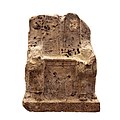 |
1907 |
1 |
| Tyre |
Louvre and National Museum of Beirut | 17 | R 800 | | | | III 30 |
|
|
 |
1907 |
1 |
| Carthage |
| 94 | I 2992 | | | | |
[42] |
| Gözne Boundary Stone |
 |
1907 |
1 |
| Gözne |
| 259 | | | | | II 34 |
|
| Thinissut sanctuary inscription |
 |
1908 |
1 |
| Bir Bouregba |
Nabeul Museum | 137 | R 942, 1858 | | | | |
|
| Gezer calendar |
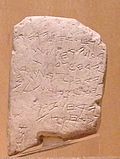 |
1908 |
1 |
| Gezer |
Museum of the Ancient Orient |
182 | R 1201 | | | | I 1 |
|
| Samaria Ostraca |
 |
1910 |
102 |
| Sebastia |
Museum of the Ancient Orient |
183–188 | | | | | I 2–3 |
|
| Olbia pedestal |
 |
1911 |
1 |
| Sardinia |
| 68 | R 1216 | | | | |
[29] |
| Giardino Birocchi inscription |
 |
1912 |
1 |
| Sardinia |
Museo Archeologico Nazionale di Cagliari |
65 | | | | | |
[29] |
| Sardis bilingual inscription |
 |
1912 |
1 |
394 BC | Sardis |
İzmir Archaeological Museum | 260 | | | | | |
|
| Rhodes Phoenician-Greek bilingual inscriptions |
 |
1914–68 |
3 |
300–200 BCE | Rhodes |
Archaeological Museum of Rhodes |
44–45 | | | | | III 39 |
|
| Bur Tlelsa Neopunic inscription |
|
1914 |
1 |
| Tunisia |
| 138 | | | | | |
|
| Kesecek Köyü inscription |
 |
1915 |
1 |
| Kesecek Köyü |
Peabody Museum of Natural History | 258 | | | | | II 33 |
|
| Aramaic Inscription of Taxila |
 |
1915 |
1 |
| Taxila |
Taxila Museum |
273 | | | | | |
|
| Arwad bilingual |
 |
1916 |
1 |
|
Arwad |
Louvre |
|
|
|
|
|
|
|
| Zattara Neopunic inscriptions |
|
1916 |
|
| Algeria |
| 171 | | | | | |
|
| Mitsri genealogy inscription |
 |
1922 |
1 |
300s BCE | Carthage |
| 78 | I 3778 | | | | |
|
|
|
1920 |
|
| Carthage |
| 75 | I 3916 | | | | |
|
| KNMY's child sacrifice(?) inscription |
 |
1922 |
1 |
| Carthage |
| 79 | I 3785 | | | | |
|
| Ibiza Phoenician inscriptions |
|
1923 |
|
| |
Archaeological Museum of Alicante | 72 | | | | | |
[43] |
| Ahiram Sarcophagus |
 |
1923 |
1 |
c.1000 BCE | Byblos |
National Museum of Beirut | 1 | | | | | III 4 |
|
| Byblos Necropolis graffito |
 |
1923 |
1 |
c.1000 BCE | Byblos |
in situ | 2 | | | | | III 5 |
|
| Byblos altar inscription |
 |
1923 |
1 |
200–100 BCE |
Byblos |
National Museum of Beirut | 12 | | | | | |
|
| Ophel ostracon |
 |
1924 |
1 |
| Jerusalem |
Rockefeller Museum | 190 | | | | | I 9 |
|
| Phoenician arrowheads |
 |
1926 onwards |
c. 70 |
11th century BCE | various |
various | 20–22 | | | | | III p. 6 |
|
| Ur Box inscription |
 |
1927 |
1 |
| Ur |
British Museum |
29 | | | | | III 20 |
|
| Byblos bronze spatulas |
 |
1926–1932 |
1 |
| Byblos |
National Museum of Beirut | 3 | | | | | III 1 |
|
| Abda sherd |
 |
1926–1932 |
1 |
c.900 BCE | Byblos |
| 8 | | | | | III 10 |
|
| Son of Safatba'al inscription |
 |
1926–1932 |
1 |
c.500/475 BCE | Byblos |
National Museum of Beirut | 9 | | | | | |
|
| Batnoam sarcophagus |
 |
1926–1932 |
1 |
c.450–425 BCE | Byblos |
National Museum of Beirut | 11 | | | | | III 26 |
|
| Sirte inscription |
|
1928 |
1 |
| Sirte |
| 180 | | | | | |
|
| Yehimilk inscription |
 |
1930 |
1 |
c.960/950 BCE | Byblos |
Byblos Castle | 4 | | | | | III 6 |
|
| Sefire steles |
 |
1930–1956 |
3 |
| As-Safira |
National Museum of Damascus and National Museum of Beirut |
222–224, 227 | | | | | II 8–9, 22 |
|
| Arslan Tash ivory inscription |
 |
1931 |
1 |
| Arslan Tash |
Louvre | 232 | | | | | II 2 |
|
| Hama graffiti |
|
1931–38 |
|
| Hama |
| 203–213 | | | | | II 6 I–V |
|
| Pul-i-Darunteh Aramaic inscription |
 |
1932 |
1 |
c.260 BCE |
Afghanistan |
in situ |
|
|
|
|
|
|
|
| Arslan Tash amulets |
 |
1933 |
2 |
| Arslan Tash |
National Museum of Aleppo |
27 | | | | | III 23–24 |
|
| Tell Halaf inscription |
 |
1933 |
1 |
| Tell Halaf |
destroyed | 231 | | | | | II 10 |
|
| Bithia inscription |
|
1933 |
1 |
| Sardinia |
| 173 | | | | | |
|
| Agrigentum inscription |
 |
1934 |
1 |
406 BCE | Carthage |
| 302 | I 5510 | | | | | [44] |
| Lachish letters |
 |
1935 |
1 |
| Tel Lachish |
British Museum and Israel Museum |
192–199 | | | | | I 12 |
|
| Safatba'al inscription |
 |
1936 |
1 |
c.900 BCE | Byblos |
National Museum of Beirut | 7 | | | | | III 9 |
|
| Hermopolis Aramaic papyri |
 |
1936 |
8 |
400s BC |
Hermopolis |
Cairo University Archaeological Museum |
| | | | | II 27 |
|
| Phoenician papyrus letters |
 |
1937–1940 |
2 |
| Cairo and Saqqara |
Egyptian Museum | 50–51 | | | | | |
|
| Melqart stele |
 |
1939 |
1 |
| Bureij |
National Museum of Aleppo |
201 | | | | | II 1 |
|
| Honeyman inscription |
 |
1939 |
1 |
900 BCE |
Cyprus |
Cyprus Museum | 30 | | | | | III 12 |
|
| Stele of Serapeitis |
 |
1940 |
1 |
| Armazi |
Georgian National Museum | 276 | | | | | |
|
| Jebel Massoudj Neopunic inscription |
|
1940 |
1 |
| Tunisia |
| 141 | | | | | |
[45][46] |
| Adon Papyrus |
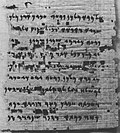 |
1942 |
1 |
| Saqqara |
Egyptian Museum | 266 | | | | | II 21 |
|
| Kilamuwa scepter |
 |
1943 |
1 |
| Sam'al |
| 25 | | | | | III 14 |
|
| Tel Qasile ostraca |
 |
1945–1946 |
2 |
| Tel Qasile |
Israel Museum | | | | | | I 4 | |
| Karatepe bilingual |
 |
1946 |
1 |
c. 750 BCE | Karatepe |
Karatepe-Aslantaş Open-Air Museum |
26 | | | | | III 15 |
|
| Tel el Maskhuta silver bowls |
|
1950s |
|
| Tel el Maskhuta |
|
| | | | | II 25 |
|
| Pumayyaton and Pnytarion's inscriptions |
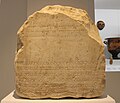 |
1950s |
1 |
c. 327 BC |
near Dromolaxia, Cyprus |
Larnaca District Archaeological Museum (n. 1425) |
|
|
|
|
|
|
[47] |
| Byblos clay cone inscriptions |
 |
1950 |
2 |
1100–1000 BCE | Byblos |
National Museum of Beirut | | | | | | III 2,3 |
|
| Carchemish Phoenician inscription |
 |
1950 |
1 |
| Carchemish |
British Museum |
28 | | | | | |
|
| Hatran Aramaic inscriptions |
 |
1951 |
|
| Hatra |
| 237–257 | | | | | |
[48][49] |
| Djinet Neopunic inscriptions |
|
1952 |
|
| Algeria |
| 170 | | | | | |
|
| Wadi Murabba'at papyrus |
|
1952 |
|
600s BC | Wadi Murabba'at |
| | | | | | I 11 | |
| KAI 136 (Neopunic) |
|
1955 |
|
| Tunisia |
| 136 | | | | | |
|
| Hazor inscriptions |
|
1956 |
|
800s BC | Tel Hazor |
| | | | | | I 5 | |
| Al Jib jar handles |
 |
1956–1959 |
>60 |
700s BC | Al Jib |
Jordan Archaeological Museum and the Penn Museum | | | | | | I 14 | |
| Byblos marble inscription |
 |
1957 |
1 |
500 BCE |
Byblos |
National Museum of Beirut | 280 | | | | | |
|
| Hashub Inscription |
 |
1957 |
1 |
400s BCE |
Tel Zeton |
Old Jaffa Museum of Antiquities |
|
|
|
|
|
|
[50] |
| Kubaba Aramaic inscription |
 |
1957 |
1 |
| Bahadırlı |
| 278 | | | | | II 36 |
[51] |
| El-Kerak Inscription |
 |
1958 |
1 |
| Al-Karak |
Jordan Archaeological Museum |
306 | | | | | I 17 |
|
| Kandahar Bilingual Rock Inscription |
 |
1958 |
1 |
| Chil Zena |
National Museum of Afghanistan |
279 | | | | | |
|
| Yavne-Yam ostracon |
 |
1960 |
1 |
| Mesad Hashavyahu |
Israel Museum |
200 | | | | | I 10 |
|
| Arad ostraca |
 |
1960s |
>200 |
c.600 BC | Tel Arad |
Bible Lands Museum | | | | | | I 13, II 31 | |
| Temple of Antas Punic inscriptions |
|
1960s |
|
|
Sardinia |
|
299–301 |
|
|
|
|
|
[29][52] |
| Nebi Yunis ostraca |
 |
1960s |
|
| Nebi Yunis (Ashdod) |
|
| | | | | II 32 |
|
| Tel Dan bowl |
|
1960s |
1 |
| Tel Dan |
|
| | | | | II 4 |
|
| Seville statue of Astarte |
 |
1960–1962 |
1 |
700 BCE | Seville |
Archeological Museum of Seville |
294 | | | | | III 16 |
|
| Khirbet Beit Lei graffiti |
 |
1961 |
7 |
400s BC | Khirbet Beit Lei |
Israel Museum | | | | | | I 15 | |
| Amman Citadel Inscription |
 |
1961 |
1 |
| Amman |
Jordan Archaeological Museum |
307 | | | | | |
|
| Ein Gev jar |
|
1961 |
|
| Ein Gev |
|
| | | | | II 3 |
|
| Cadiz Phoenician gold ring inscription |
|
1961 |
|
| |
Instituto Valencia of Don Juan | 71 | | | | | |
[53] |
| Phoenician Sphinx inscription |
 |
1962 |
1 |
|
Umm al-Amad |
National Museum of Beirut |
| | | | | III 32 |
|
| Baalshillem Temple Boy |
 |
1963–1964 |
1 |
| Sidon |
National Museum of Beirut |
281 | | | | | III 29 |
|
| Abydos Aramaic papyrus |
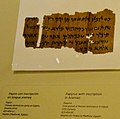 |
1964 |
1 |
400s BC |
unknown |
National Archaeological Museum of Madrid |
| | | | | II 29 |
|
| Pyrgi Tablets |
 |
1964 |
3 |
| Pyrgi |
National Etruscan Museum |
277 | | | | | III 42 |
|
| Carthage Administration Inscription |
 |
1964 |
1 |
| Carthage |
Carthage National Museum |
303 | | | | | |
|
| Luristan Aramaic inscriptions |
|
1964 |
|
| Luristan |
|
| | | | | II 11–12 |
|
| Daskyleion steles |
 |
1965 |
|
| Dascylium |
Museum of the Ancient Orient |
318 | | | | | II 37 |
|
| Mozia Punic inscriptions |
|
1967 |
|
|
Sicily |
|
296–298 |
|
|
|
|
|
[54][29][55] |
| Deir Alla Inscription |
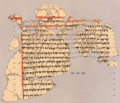 |
1967 |
1 |
| Deir Alla |
Jordan Archaeological Museum | 312 | | | | | |
|
| Grotta Regina Punic inscriptions |
|
1969 |
|
|
Sicily |
|
295 |
|
|
|
|
|
[56][29] |
| Kition KAI 288–290 |
|
1970s-80s |
|
|
Kition |
|
288–290 |
|
|
|
|
|
[57][58][59] |
| Tekke Bowl Inscription (Knossos) |
|
1970s |
|
1,000s BCE | Crete |
Heraklion Archaeological Museum (Χ4346) | 291 | | | | | |
[60][61][62] |
| Aramaic Sustenance tablet |
|
1970s |
|
|
|
|
316 |
|
|
|
|
|
[63][64][65][66] |
| Aramaic inscription of Laghman |
 |
1970 |
1 |
c.260 BCE |
Afghanistan |
in situ |
|
|
|
|
|
|
|
| Aramaic Fugitive Decree |
|
1971 |
|
|
Unknown |
|
317 |
|
|
|
|
|
[67][68] |
| Tel Siran inscription |
 |
1972 |
1 |
| Amman |
Jordan Archaeological Museum |
308 | | | | | |
|
| Letoon trilingual |
 |
1973 |
1 |
| Xanthos |
Fethiye Museum |
319 | | | | | |
|
| Aramaic inscription from al-Mal |
|
1973 |
|
7/6 BC |
al-Mal |
|
|
|
|
|
|
|
|
| Tell Sheikh Hamad inscriptions |
|
1978–1980s |
|
|
Tell Sheikh Hamad |
|
313–314 |
|
|
|
|
|
[69] |
| Hadad-yith'i bilingual inscription |
 |
1979 |
1 |
| Tell Fekheriye |
National Museum of Damascus | 309 | | | | | |
|
| Ketef Hinnom scrolls |
 |
1979 |
2 |
650–587 BCE |
Jerusalem |
Israel Museum |
|
|
|
|
|
|
|
| Sarepta Tanit Inscription |
 |
1980s |
|
| Sarafand |
|
285 | | | | | |
[70] |
| Çebel Ires Daǧı inscription |
 |
1980 |
1 |
| Çebel Ires Daǧı |
Alanya Archaeological Museum | 287 | | | | | |
|
| Abdalonymos bilingual |
|
1982 |
1 |
325 BCE | Kos |
| 292 | | | | | |
[71][72] |
| Monumental Hebrew inscription from Jerusalem [he] |
 |
1982 |
1 |
800–500 BCE |
Byzantine Spolia near the Southern Wall |
Israel Museum |
|
|
|
|
|
|
[73] |
| Hazael horse frontlet |
 |
1984 |
1 |
800 BCE | Samos |
Archaeological Museum of Vathi | 311 | | | | | |
|
| Bukan inscription |
|
1985 |
|
|
Bukan |
|
320 |
|
|
|
|
|
[74][75] |
| İvriz inscription |
|
1986 |
|
|
75 meter upstream from the İvriz relief[76] |
|
unpublished |
[77] |
| Bactria Aramaic documents |
 |
1993–2002 |
|
353–324 BCE | Bactria |
Khalili Collections | | | | | | |
|
| Tel Dan Stele |
 |
1993 |
1 |
| Tel Dan |
Israel Museum |
310 | | | | | |
|
| Tell Shiukh Fawqani inscription |
|
1996 |
|
|
|
|
315 |
|
|
|
|
|
[78] |
| Ekron Royal Dedicatory Inscription |
 |
1996 |
1 |
| Tel Miqne |
Israel Museum |
286 | | | | | |
|
| Çineköy inscription |
 |
1997 |
1 |
| Çine, Yüreğir |
Adana Archaeology Museum |
| | | | | |
[79][80] |
| Tablet De Geest |
|
2000 |
1 |
200s CE |
Socotra |
in situ |
|
|
|
|
|
|
|
| Zayit Stone |
 |
2005 |
1 |
c. 900 BCE |
Tel Zayit |
|
|
|
|
|
|
|
|
| Kuttamuwa stele |
 |
2008 |
1 |
| Sam'al |
Gaziantep Archaeology Museum |
| | | | | |
[81] |
| Khirbet Qeiyafa ostracon |
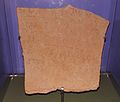 |
2009 |
1 |
c. 1000 BCE |
Khirbet Qeiyafa |
Israel Museum |
|
|
|
|
|
|
[82] |
| Ataruz altar inscriptions |
|
2010 |
|
c. 800 BCE |
Khirbat Ataruz |
|
|
|
|
|
|
|
[83] |
| Ishbaal Inscription |
 |
2012 |
|
1020–980 BCE |
Khirbet Qeiyafa |
|
|
|
|
|
|
|
[84] |
| KAI 283 |
|
|
|
|
Sidon |
|
283 | | | | | |
[85] |
| KAI 284 |
|
|
|
|
Tyre |
|
284 | | | | | |
[86] |
| Demetrias inscription |
|
|
|
| Demetrias |
| 293 | | | | | |
|
|
